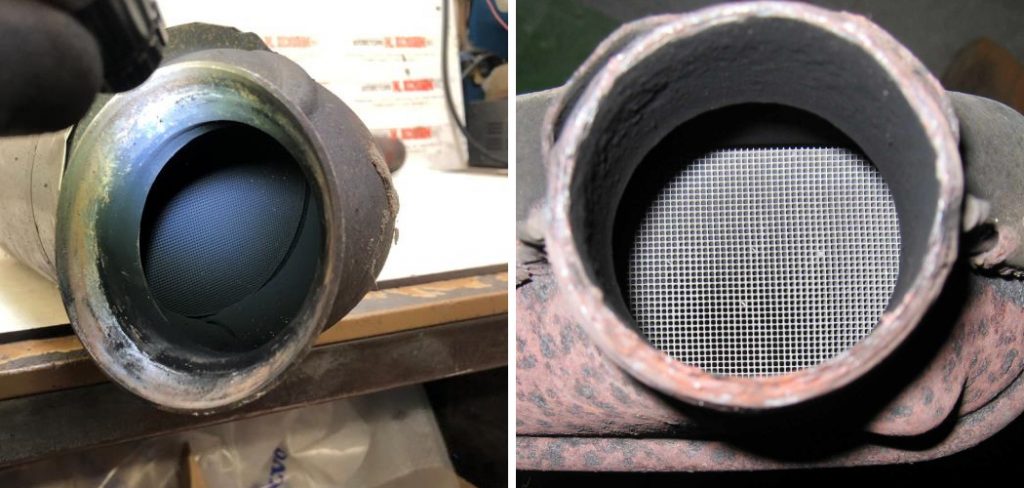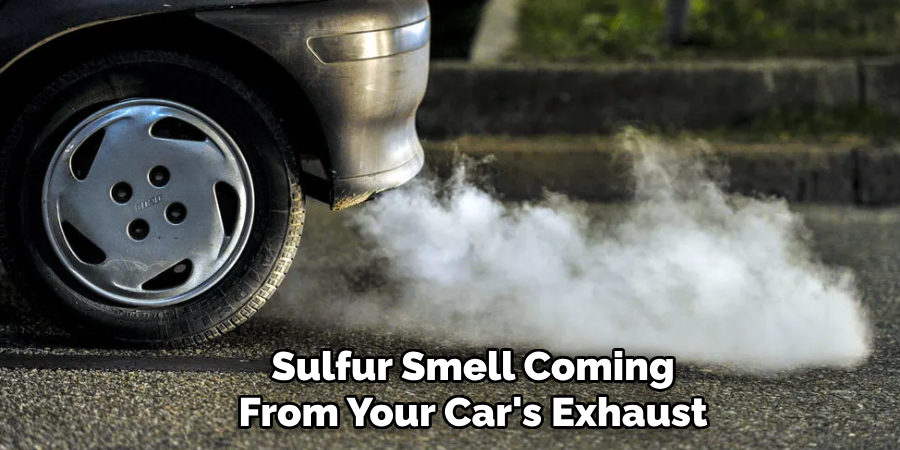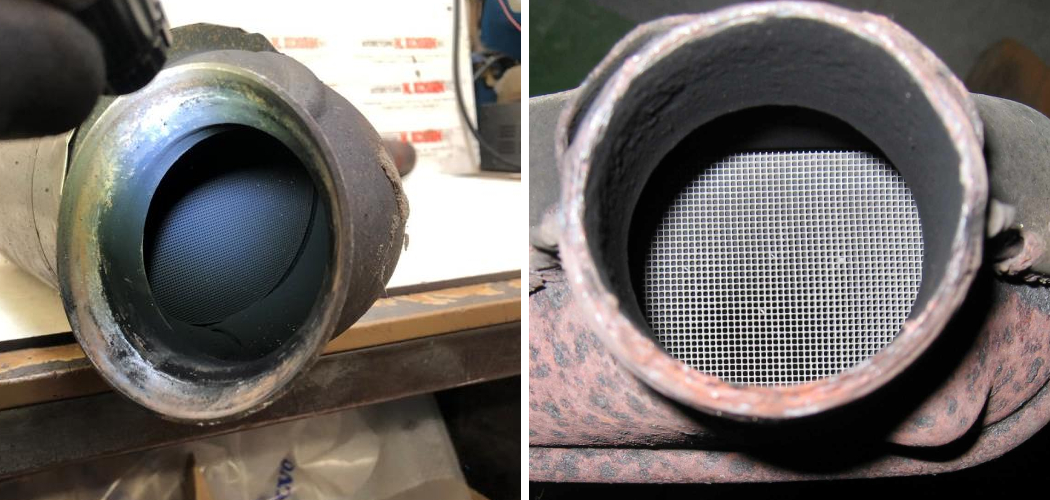Have you noticed that your car isn’t accelerating as well as it used to? Or maybe the check engine light has popped on and you’re wondering what could be causing it? If so, there’s a good chance your catalytic converter could be to blame. The catalytic converter is an important emissions control device located in your vehicle’s exhaust system. Its purpose is to reduce air pollutants coming out of your car by converting them into less harmful substances through high-temperature chemical reactions.

While durable, over time the honeycomb-like structure inside your catalytic converter can become clogged with debris and toxins, making it less effective at doing its job. A clogged catalytic converter will result in poorer gas mileage, reduced engine performance, and higher emissions.
In this article, I’ll go over some common signs that your catalytic converter may need attention and show you a few simple ways how to check a catalytic converter is clogged to check if it’s blocked up so you can determine if repairs or replacement are needed.
Needed Materials
- Safety Glasses
- Work Gloves
- Flashlight
- Jack and Jack Stands or a Car Ramp
- Protective Knee Pad (Optional)
11 Step-by-step Guidelines on How to Check a Catalytic Converter is Clogged
Step 1: Safety First
Before performing any work on your vehicle, always remember to put safety first. Make sure you are wearing safety glasses and work gloves to protect yourself from any potential hazards. Otherwise, you could end up with a trip to the hospital instead of fixing your car. It’s also a good idea to wear a protective knee pad if you’re working on your car on the ground.

Step 2: Locate Your Catalytic Converter
Your catalytic converter is typically located underneath your vehicle, between the exhaust manifold and muffler. You may need to jack up your car or use a car ramp to access it more easily. But please make sure to follow proper safety precautions when lifting your car off the ground. The catalytic converter is usually a round or oval-shaped metallic canister.
Step 3: Perform a Visual Inspection
Once you’ve located your catalytic converter, visually inspect it for any signs of physical damage. Look for dents, cracks, rust or other types of corrosion on the surface. If you notice anything suspicious, it’s best to have a professional mechanic take a closer look. It’s also a good idea to check the heat shield, which surrounds the converter, for any damage.
Step 4: Check for Rattling Noises
Give your catalytic converter a tap with a rubber mallet or the palm of your hand. If you hear any rattling noises, this could be an indication that the internal honeycomb structure has broken apart and is clogging the exhaust flow. You may also hear rattling noises while the car is running. The sound could be coming from loose internal components of the catalytic converter.
Step 5: Perform a Temperature Test
Start your vehicle and let it run for a few minutes until it reaches normal operating temperature. Then, carefully (using gloves) touch the catalytic converter to check its temperature. If it’s too hot to touch, this could be an indication that the internal honeycomb structure is clogged and not allowing proper exhaust flow. The converter should still be warm to the touch, but not hot.
Step 6: Check for Sulfur Smell

If you notice a strong sulfur smell coming from your car’s exhaust, this could also be an indication of a clogged catalytic converter. A clogged converter may not be able to properly convert the sulfur in your fuel into less harmful substances, resulting in an unpleasant smell. It’s important to note that a sulfur smell could also be caused by other issues, so it’s best to have a mechanic diagnose the issue.
Step 7: Conduct an Emissions Test
If you have access to an emissions testing machine, you can use it to check your car’s emission levels. If there is a significant increase in levels compared to your last test, this could be an indication of a clogged catalytic converter. But keep in mind that other factors can also affect emissions levels, so it’s best to have a mechanic confirm the issue.
Step 8: Use an OBD-II Scanner
If your check engine light is on, you can use an OBD-II scanner to read the error codes and see if the catalytic converter is one of the potential issues. However, keep in mind that a check engine light can also be triggered by other problems, so it’s best to have a mechanic further diagnose the issue. The scanner can also clear the codes and turn off the check engine light if needed.
Step 9: Inspect the Oxygen Sensor
The oxygen sensor is responsible for monitoring and controlling exhaust gases before they enter the catalytic converter. If it’s not functioning properly, it can cause the converter to become clogged. You can visually inspect the sensor for any damage or replace it if needed. You can also use an OBD-II scanner to check for any error codes related to the oxygen sensor.
Step 10: Look for Reduced Engine Performance

If your car is struggling to accelerate and feels less powerful than usual, this could also be a sign of a clogged catalytic converter. The blockage restricts exhaust flow, which can negatively impact engine performance. If you notice a significant decrease in your car’s power and performance, it’s best to have a mechanic check the catalytic converter and other potential issues.
Step 11: Seek Professional Help
If you’ve gone through the above steps and suspect that your catalytic converter is clogged, it’s best to seek professional help. A mechanic can perform a more in-depth inspection and determine if the converter needs to be repaired or replaced. They can also diagnose any other potential issues that may be causing similar symptoms. Remember, it’s always better to have an expert take care of your car’s problems for optimal results.
Following these simple steps on how to check if a catalytic converter is clogged will help you determine if your catalytic converter is clogged and needs attention. By regularly inspecting and maintaining your vehicle’s components, you can prevent costly repairs in the future. And remember, safety always comes first when working on your car. Happy driving!
Frequently Asked Questions
Q1: How Often Should I Check My Catalytic Converter?
A1: It’s a good idea to visually inspect your catalytic converter every time you perform an oil change or other routine maintenance. However, if you notice any unusual symptoms, it’s best to check it immediately. The more frequently you check, the better your chances of catching any potential issues early on.
Q2: Can I Clean My Catalytic Converter?

A2: In some cases, a clogged catalytic converter can be cleaned using specialized cleaning products. However, it’s important to note that this may only be a temporary solution and may not work for severe clogs or physical damage. It’s best to consult with a mechanic for the best course of action.
Q3: What Are Some Common Symptoms of a Clogged Catalytic Converter?
A3: Some common symptoms include reduced engine performance, rattling noises, strong sulfur smell from exhaust, and an increase in emissions levels. These symptoms can also be indicative of other issues, so it’s best to have a professional diagnose the problem.
Q4: How Can I Prevent My Catalytic Converter from Getting Clogged?
A4: Proper maintenance of your vehicle is key to preventing clogs in the catalytic converter. Regularly changing your oil, using high-quality fuel, and addressing any engine issues promptly can help maintain the health of your converter. Additionally, avoid driving your car with a misfiring engine, as this can lead to excess fuel entering the converter and causing damage.
Conclusion
In conclusion on how to check a catalytic converter is clogged, knowing how to check for a clogged catalytic converter is an important skill for all car owners to have. Not only can a clogged converter affect your vehicle’s performance and fuel efficiency, but it can also be harmful to the environment. By following these simple steps and regularly inspecting your catalytic converter, you can save yourself from potentially costly repairs and help reduce pollution.
Remember, prevention is always better than cure, and by being proactive in checking your converter, you can avoid any major issues down the road. It’s also worth mentioning that if you do suspect a clogged catalytic converter, it’s best to take your car to a trusted mechanic for further diagnosis and repairs. Your safety should always come first when handling any car maintenance tasks.
Additionally, don’t forget about proper maintenance of your vehicle’s engine and exhaust system as well. Keeping these components clean and in good condition will prolong the life of your catalytic converter and ensure that your car runs smoothly for years to come. So next time you’re on the road or performing routine maintenance on your car, remember the signs of a clogged catalytic converter and take action if needed. Your car (and the environment) will thank you!

